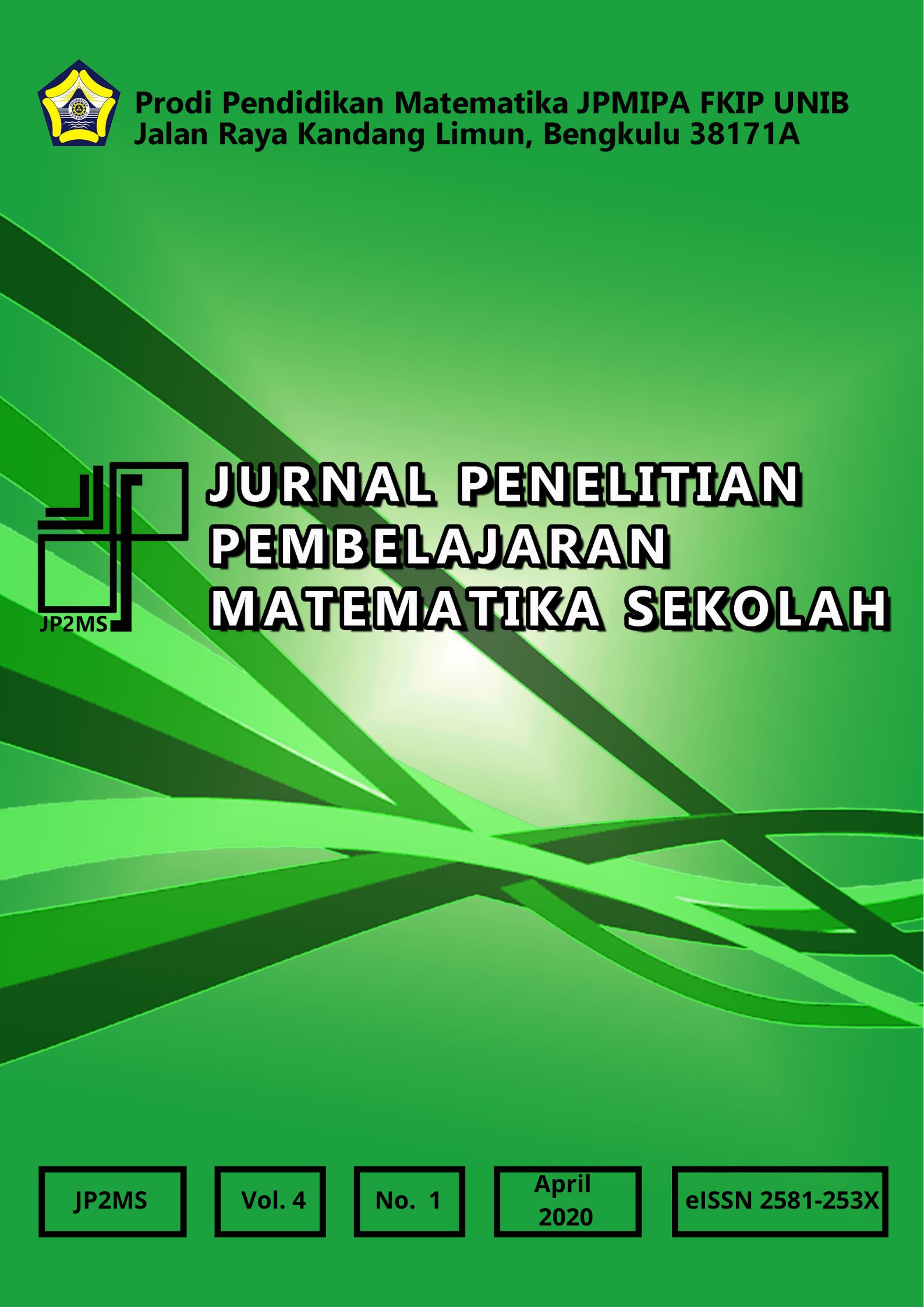Main Article Content
Abstract
ABSTRAK
Penelitian ini bertujuan untuk menghasilkan LKPD Matematika dengan model Project Based Learning pada materi bangun ruang sisi datar yang memenuhi kriterita valid, praktis, dan efektif. Jenis penelitian ini adalah penelitian dan pengembangan dengan memodifikasi prosedur 4-D Thiagarajan yaitu tahap pendefenisian, tahap perancangan, dan tahap pengembangan. Instrumen yang digunakan adalah lembar validasi, lembar kepraktisan, dan lembar efektivitas. Hasil Penelitian menunjukkan bahwa pengembangan LKPD matematika dengan model Project Based Learning pada materi bangun ruang sisi datar kelas VIII di SMP Negeri 14 Kota Bengkulu termasuk dalam kategori: (1) LKPD Matematika termasuk dalam kategori sangat valid dengan skor rata-rata 4,41, dibuktikan dengan cara (a) LKPD menunjukkan kebenaran dan kesesuaian urutan dengan langkah – langkah model Project Based Learning pada validasi materi, (b) tulisan, gambar dan penampilan pada LKPD yang menarik serta mudah dibaca pada validasi konstruksi, dan (c) penggunaan kalimat sederhana, jelas dan mudah dipahami serta penggunaan kalimat Tanya dan kalimat perintah sesuai pada validasi bahasa, (2) LKPD Matematika termasuk dalam kategori sangat praktis dengan skor rata-rata 4,31, dibuktikan dengan cara petunjuk, langkah – langkah, gambar, dan permasalahan pada LKPD mudah dipahami oleh peserta didik, dan (3) LKPD Matematika termasuk dalam kategori sangat efektif dengan skor rata-rata 4,53, dibuktikan dengan cara langkah – langkah pada LKPD membimbing peserta didik memahami konsep menyelesaikan masalah, langkah model project based learning membantu peserta didik dalam menyelesaikan tes hasil belajar dengan persentase ketuntasan 96,55%.
ABSTRACT
This research aimed to produce Mathematics LKPD by using Project Based Learning of Geometry Flat Side that fulfils valid, practical, and effective criteria. The type of research is Research and Development by adopting the Thiagarajan 4-D procedure, namely the stage of defining, designing, and developing. The research instruments used were the validation sheet, the practicality sheet, and the effectiveness sheet. The results the development of Mathematics LKPD by using Project Based Learning Model in Geometry Flat Side at the Second Grade of SMP Negeri 14 Kota Bengkulu showed that: (a) Mathematical LKPD was categorized in the very valid category with an average score of 4.41, proved by means of (a) LKPD shows the truth and suitability of the sequence with the steps of the Project Based Learning model in material validation, (b) writing, images and appearance on LKPD’s that are interesting and easy to read on construction validation, and (c) the sentences were simple, clear and easy-to-understand and the question sentences and command sentences according to language validation, (2) Mathematics LKPD is included in the very practical category with an average score 4.31, proved by means of instructions, steps, pictures, and problems in LKPD easily understood by students, and (3) LKPD Mathematics is included in the very effective category with an average score of 4.53, proved by means of steps in LKPD guides students to understand the concept of solving problems, the step of the project based learning model helps students complete the learning outcomes test with a percentage of completeness 96.55%.
Keywords
Article Details
An author who publishes in the Jurnal Penelitian Pembelajaran Matematika Sekolah agrees to the following terms:
Author retains the copyright and grants the Journal the right of first publication of the work simultaneously licensed under the Creative Commons Attribution-ShareAlike 4.0 License that allows others to share the work with an acknowledgement of the work's authorship and initial publication in this journal.
Submission of a manuscript implies that the submitted work has not been published before (except as part of a thesis or report, or abstract); that it is not under consideration for publication elsewhere; that its publication has been approved by all co-authors. If and when the manuscript is accepted for publication, the author(s) still hold the copyright and retain publishing rights without restrictions. For the new invention, authors are suggested to manage its patent before published. The license type is CC-BY-SA 4.0.
Jurnal Penelitian Pembelajaran Matematika Sekolah is licensed under a Creative Commons Attribution-ShareAlike 4.0 International License.
